-
ORIGINAL ARTICLE12-08-2023
Early ambulation and dhikr complementary therapies effect on intestinal peristaltic in post-open cholecystectomy patients
Revista Brasileira de Enfermagem. 2023;76:e20220636
Abstract
ORIGINAL ARTICLEEarly ambulation and dhikr complementary therapies effect on intestinal peristaltic in post-open cholecystectomy patients
Revista Brasileira de Enfermagem. 2023;76:e20220636
DOI 10.1590/0034-7167-2022-0636
Views0ABSTRACT
Objectives:
to analyze and determine the effect of a combination intervention of early ambulation and dhikr therapy on intestinal peristaltic recovery in post-open cholecystectomy patients.
Methods:
a pre-experimental design with one group pre and post-test design was used. The samples were 15 post-open cholecystectomy patients which were selected using the purposive sampling technique. The data were collected using the instrument observation sheet and analyzed using the Wilcoxon test. Early ambulation used standard operational procedure in the hospital and dhikr therapy was carried out at 2 hours post-operation for 10-15 minutes.
Results:
there was an effect of early ambulation and dhikr therapy on intestinal peristaltic recovery in post-open cholecystectomy patients with general anesthesia (Z=-3.442; p=0.001).
Conclusions:
a combination of early ambulation and dhikr therapy can be recommended as interventions to improve intestinal peristaltic in a post-open cholecystectomy patient with general anesthesia.
Keywords:Anesthesia, GeneralCholecystectomyComplementary TherapiesEarly AmbulationPerioperative NursingSee more -
ORIGINAL ARTICLE12-08-2023
Systematization of perioperative nursing care in robotic surgery: instrument validation
Revista Brasileira de Enfermagem. 2023;76:e20220666
Abstract
ORIGINAL ARTICLESystematization of perioperative nursing care in robotic surgery: instrument validation
Revista Brasileira de Enfermagem. 2023;76:e20220666
DOI 10.1590/0034-7167-2022-0666
Views0See moreABSTRACT
Objective:
To develop and validate an instrument to assist in the systematization of perioperative nursing care in robotic surgery.
Methods:
Methodological study developed in four phases: content survey; textual elaboration; content validation by the group of expert judges and target audience; and elaboration of the electronic instrument layout.
Results:
Eleven expert judges and seven evaluators of the target audience participated. For validation, the Content Validity Index (CVI) was used with a 0.78 cutoff point. The instrument total CVI after evaluation was 0.90 by the expert judges and 0.88 by the target audience.
Conclusion:
The tool built was proved satisfactory for the systematization of perioperative nursing care. The instrument construction was based on the updated scientific literature and validated by the expert judges and target audience.
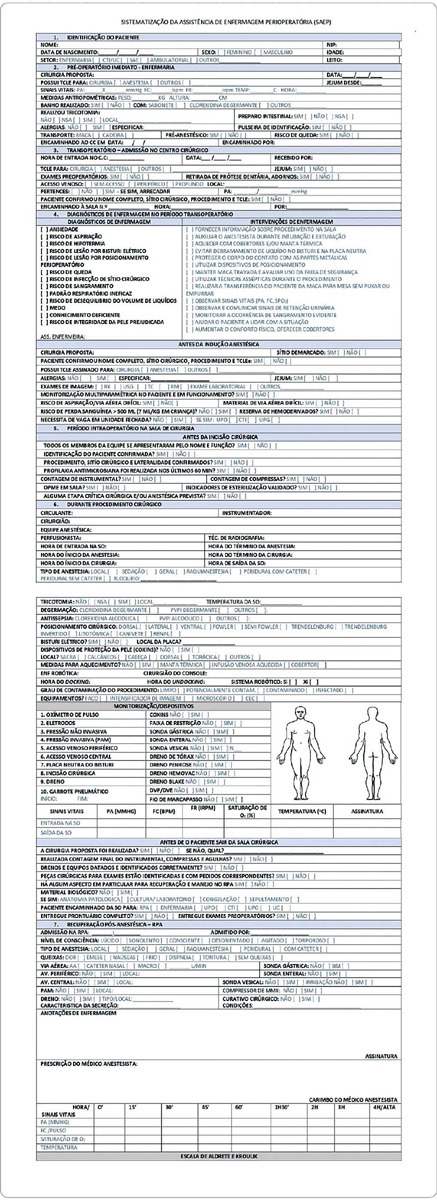
-
12-08-2023
Nursing experiences in specialized services in child and adolescent mental health: a systematic review of qualitative studies
Revista Brasileira de Enfermagem. 2023;76:e20220550
Abstract
Nursing experiences in specialized services in child and adolescent mental health: a systematic review of qualitative studies
Revista Brasileira de Enfermagem. 2023;76:e20220550
DOI 10.1590/0034-7167-2022-0550
Views1See moreABSTRACT
Objective:
to synthesize evidence from qualitative studies on nursing experiences regarding child and adolescent mental health care in specialized services.
Method:
a systematic review with meta-synthesis of qualitative studies according to JBI guidelines. CINAHL, EMBASE, MEDLINE, LILACS, PSYCinfo, Scopus and Web of Science databases were used. The findings were classified according to the level of reliability and credibility and categorized by similarity between contents.
Results:
229 articles were identified, and five were included in the final sample and organized into the categories: Emotional impact; and Understanding nursing role. The level of evidence found was moderate.
Final considerations:
nursing experiences are permeated by emotional exhaustion, feelings of frustration and difficulty in understanding their professional role. The need for training spaces that qualify this care is highlighted.
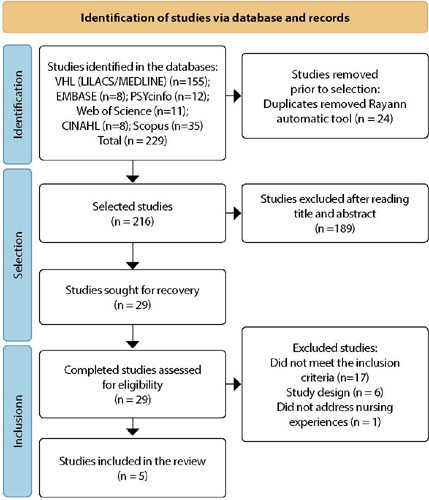
-
ORIGINAL ARTICLE12-08-2023
The relationship between level of knowledge and vaginal discharge prevention behavior for nursing student
Revista Brasileira de Enfermagem. 2023;76:e20220602
Abstract
ORIGINAL ARTICLEThe relationship between level of knowledge and vaginal discharge prevention behavior for nursing student
Revista Brasileira de Enfermagem. 2023;76:e20220602
DOI 10.1590/0034-7167-2022-0602
Views0See moreABSTRACT
Objective:
Reproductive health in adolescent girls is very important. To determine the relationship between the level of knowledge and the behavior of preventing vaginal discharge among nursing students.
Methods:
a quantitative, cross-sectional study, with 155 first-year female students at a private faculty of nursing. Data were collected from February to March 2022, using an electronic questionnaire.
Results:
98.1% of participants have a good level of knowledge and 92.3% of participants practice good vaginal discharge prevention behavior.
Conclusion:
good knowledge produces appropriate prevention behavior. The result of this study can be used as a contribution of thoughts and references as a more in-depth study of the factors that influence the level of knowledge and behavior about the disease of the genitalia and the dangers of pathological vaginal discharge.
-
ORIGINAL ARTICLE12-08-2023
Fear of COVID-19 when experiencing pregnancy or childbirth in the pandemic: what are the associated factors?
Revista Brasileira de Enfermagem. 2023;76:e20220755
Abstract
ORIGINAL ARTICLEFear of COVID-19 when experiencing pregnancy or childbirth in the pandemic: what are the associated factors?
Revista Brasileira de Enfermagem. 2023;76:e20220755
DOI 10.1590/0034-7167-2022-0755
Views0See moreABSTRACT
Objective:
to identify factors associated with fear of COVID-19 among women who experienced pregnancy or childbirth during the pandemic.
Methods:
a cross-sectional study, nested within a prospective cohort, using an online survey, from August 2021 to February 2022, based on descriptive data analysis.
Results:
of the 431 participants, 52.8% were postpartum women and 20.1% were pregnant women. With regard to fear of COVID-19, a mean score of 20.46 was obtained (moderate fear). The highest fear scores were present in women whose newborns were admitted to hospital in neonatal critical units (p=0.032), and the lowest among those covered by supplementary health (insurance) (p=0.016).
Conclusion:
among pregnant and postpartum women, high fear of COVID-19 translated into the possibility of having newborns admitted to hospital in a critical unit. The importance of supporting actions to support pregnant/postpartum women’s mental health in relation to COVID-19 or other threats that may influence the neonatal outcome stands out.
-
ORIGINAL ARTICLE12-08-2023
Care for older adults with disabilities in Long Term Care Facility
Revista Brasileira de Enfermagem. 2023;76:e20220767
Abstract
ORIGINAL ARTICLECare for older adults with disabilities in Long Term Care Facility
Revista Brasileira de Enfermagem. 2023;76:e20220767
DOI 10.1590/0034-7167-2022-0767
Views0See moreABSTRACT
Objective:
to analyze the constitution of care offered to older adults with disabilities, from Long Term Care Facility professionals’ perspective.
Methods:
this is a discourse analysis based on the post-structuralist framework. Participants in this study are professionals involved in the care for older adults, totaling 14 respondents, 13 women and one man.
Results:
from professionals’ perspective, there is a fine line between caring for older adults with disabilities and maintaining their autonomy. Care in which autonomy is restricted predisposes older adults to a process of dependency.
Final considerations:
caring for older adults with disabilities constitutes the challenge between caring and maintaining independence. Thus, older adult-centered care should be taken as a premise so that their individualities are respected.
-
ORIGINAL ARTICLE12-08-2023
Polypharmacy, potentially inappropriate medications and associated factors among older adults with hypertension in primary care
Revista Brasileira de Enfermagem. 2023;76:e20220785
Abstract
ORIGINAL ARTICLEPolypharmacy, potentially inappropriate medications and associated factors among older adults with hypertension in primary care
Revista Brasileira de Enfermagem. 2023;76:e20220785
DOI 10.1590/0034-7167-2022-0785
Views0See moreABSTRACT
Objective:
to identify the prevalence and associations of polypharmacy and potentially inappropriate medication use among older adults with hypertension treated in primary care.
Methods:
a cross-sectional study carried out with older adults with hypertension treated at a Family Health Strategy unit. Data collection included analysis of medical records, interviews and multidimensional assessment of older adults. Socio-demographic information and clinical variables were collected. Statistical analysis was performed by multiple logistic regression.
Results:
polypharmacy prevalence was 38.09%, and potentially inappropriate medication (PIM), 28.57%. There was a significant association between polypharmacy and PIM use, altered sleep and ethnicity. PIM use was associated with polypharmacy, worse family functioning, and absence of a caregiver. Cognitive decline reduces the prevalence of these medications.
Conclusions:
polypharmacy and PIM use among older adults with hypertension represent a problem in this population, especially among the most vulnerable.
-
ORIGINAL ARTICLE12-08-2023
Social support networks and life cycle stage of Venezuelan immigrant families
Revista Brasileira de Enfermagem. 2023;76:e20220790
Abstract
ORIGINAL ARTICLESocial support networks and life cycle stage of Venezuelan immigrant families
Revista Brasileira de Enfermagem. 2023;76:e20220790
DOI 10.1590/0034-7167-2022-0790
Views0See moreABSTRACT
Objective:
To understand the structures of social networks of interiorized Venezuelan immigrant families and the life cycle stage they are in.
Methods:
Qualitative multiple-case study with families from the Interiorization Program residing in the Greater Florianópolis, Brazil. Screening occurred through social networks and key informants. For data collection, the photovoice technique and semi-structured interviews were used, categorized with the help of the Atlas.ti software. Genograms and ecomaps were elaborated.
Results:
Of the 4 families interviewed, totaling 7 members with young children, the nuclear family was identified as the main informal support network. Formal networks included schools, churches, and civil society.
Conclusion:
Families rely heavily on their nuclear structure for support, with formal institutions acting as secondary resources. The predominant life cycle stage is focused on families with young children. More efforts are needed to strengthen formal support networks.
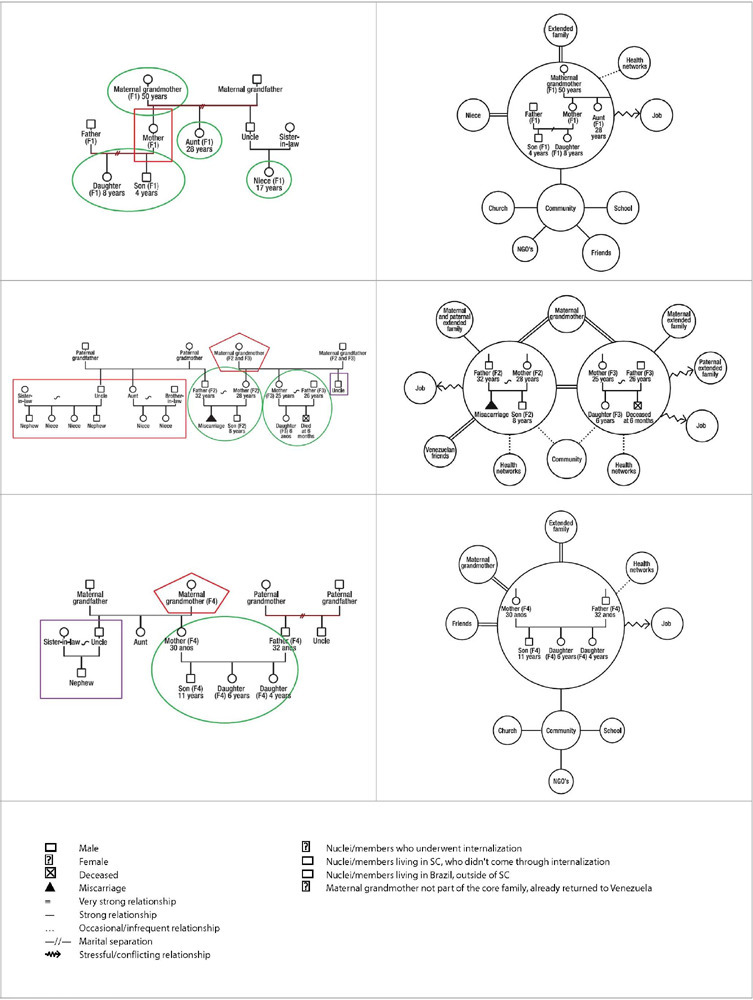
-
REVIEW06-10-2022
Self-inflicted violence and suicide in people living with HIV/AIDS: a systematic review
Revista Brasileira de Enfermagem. 2022;75:e20210768
Abstract
REVIEWSelf-inflicted violence and suicide in people living with HIV/AIDS: a systematic review
Revista Brasileira de Enfermagem. 2022;75:e20210768
DOI 10.1590/0034-7167-2021-0768
Views0See moreABSTRACT
Objectives:
to analyze intellectual productions on self-inflicted violence and suicide in people living with HIV/AIDS.
Methods:
a systematic review, carried out between March and April 2021, in the PubMed®/MEDLINE®, Web of Science and LILACS databases, subsidized in the Strengthening the Reporting of Observational Studies in Epidemiology. The period outlined was from 2011 to 2020.
Results:
a total of 199 studies were identified, and 16 composed the final sample, grouped into the categories: Sociodemographic characteristics of victims of self-inflicted violence/suicide and their intervening factors (pointing to young adults, especially homosexuals, with low social support and a history of mental illness or substance abuse as usual victims); Successful measures for suicide prevention/control in people living with HIV/AIDS (suggesting more frequent psychosocial and clinical follow-up of those starting antiretroviral and immunocompromised treatment).
Conclusions:
biopsychosocial follow-up, analysis of sociodemographic profile and intervening factors should be frequent in this population for disease prevention/control.

-
ORIGINAL ARTICLE09-05-2022
Screening for common mental disorder in elderly residents in the countryside: a cross-sectional study
Revista Brasileira de Enfermagem. 2022;75:e20210875
Abstract
ORIGINAL ARTICLEScreening for common mental disorder in elderly residents in the countryside: a cross-sectional study
Revista Brasileira de Enfermagem. 2022;75:e20210875
DOI 10.1590/0034-7167-2021-0875
Views0See moreABSTRACT
Objective:
To estimate the prevalence of common mental disorders and their associated factors in the elderly in a municipality in the countryside of the Brazilian Midwest.
Methods:
Quantitative, observational, cross-sectional approach research, conducted with 218 elderly people.
Results:
The prevalence of the common mental disorder among the elderly was 25.1%; in the univariate analysis, it was higher in females (35.4%), in the age group of 80 years or older (46.1%), brown skin color (30.2%), widowed (42.6%), illiterate (47.6%), and retired (27.6%). In the multiple analysis, the variables female gender (p<0.006), age 80 years or older (p<0.036), dissatisfaction with life (p<0.009), lack of social interaction (p=0.017), and dysfunctional family (p=0.021) remained associated with CMD.
Conclusion:
The results revealed are helpful and contribute to the reinforcement of the need for mental health care in this population extract so growing worldwide.
-
ORIGINAL ARTICLE06-03-2022
Association between falls in older adults and prevention group
Revista Brasileira de Enfermagem. 2022;75:e20200207
Abstract
ORIGINAL ARTICLEAssociation between falls in older adults and prevention group
Revista Brasileira de Enfermagem. 2022;75:e20200207
DOI 10.1590/0034-7167-2020-0207
Views0See moreABSTRACT
Objectives:
to assess the effectiveness of guidelines on fall prevention in a group of older adults in Primary Health Care.
Methods:
a cross-sectional study, carried out with older adults selected by a simple random sample (274; N=1,234). Data covered sociodemographic and socioeconomic variables, marital status, health conditions, factors associated with falls and participation in the prevention group. Student’s t test was used, and dichotomous variables were used by the chi-square test. The project met ethical requirements.
Results:
sample with female profile (61.7%), married, with low education, mean age of 71.69 years. The factors associated with falls identified were female sex, medicalization and participation in the prevention group. There was no protective association between participation in a fall prevention group in older adults and a decrease in the number of falls.
Conclusions:
based on evidence, a personalized intervention during the nursing visit is suggested as a strategy to prevent falls.

-
ORIGINAL ARTICLE03-07-2022
Predictors of frailty in older people users of Primary Health Care
Revista Brasileira de Enfermagem. 2022;75:e20201292
Abstract
ORIGINAL ARTICLEPredictors of frailty in older people users of Primary Health Care
Revista Brasileira de Enfermagem. 2022;75:e20201292
DOI 10.1590/0034-7167-2020-1292
Views0See moreABSTRACT
Objective:
to identify the prevalence and predictors of frailty in older people in Primary Health Care.
Method:
this is a descriptive and correlational study, carried out in a convenience sample of 136 older people in the community. Data were collected through a sociodemographic and clinical questionnaire and frailty phenotype. Student’s t test or U-Mann-Whitney test, chi-square and binary logistic regression were used for data analysis.
Results:
the prevalence of frailty was 26.5% (n=36). Frail individuals had older age (p=0.011), worse self-rated health (p=0.001) and lower physical capacity (p<0.001). In the multivariable regression, it was observed that frail individuals had older age (Odds Ratio=1.111; 95% confidence interval=1.026-1.203) and worse physical capacity (Odds Ratio=0.673; 95% confidence interval=0.508-0.893).
Conclusions:
the prevalence of frailty in older people in Primary Health Care was considerable. Advanced age and worse physical capacity were the most relevant predictors of frailty in the elderly.
-
ORIGINAL ARTICLE04-15-2022
Validation of Questionnaire to Assess the Impact of Dementia on the Family
Revista Brasileira de Enfermagem. 2022;75:e20210232
Abstract
ORIGINAL ARTICLEValidation of Questionnaire to Assess the Impact of Dementia on the Family
Revista Brasileira de Enfermagem. 2022;75:e20210232
DOI 10.1590/0034-7167-2021-0232
Views0See moreABSTRACT
Objective:
To validate a questionnaire to assess the impact of dementia on one of the household members.
Methods:
Methodological study. The instrument was designed based on literature review, expert opinion, and researchers’ experience and then applied to a non-probability convenience sample consisting of 262 family members who live daily with a person with dementia. The construct validity was studied by exploratory factor analysis, principal components method, with varimax rotation of the items.
Results:
An instrument with 30 items was obtained, distributed in four dimensions: “Emotional dimension,” “Economic dimension,” “Family relations dimension,” and “Support-seeking dimension.” Factor analysis revealed a total explained variance of 54.96% and a total Cronbach’s alpha of .899.
Conclusions:
The instrument presents high internal consistency, grouped into four dimensions, all closely related to the family’s adaptation to the onset of dementia in one of its members.
-
ORIGINAL ARTICLE03-07-2022
Is self-esteem associated with the elderly person’s quality of life?
Revista Brasileira de Enfermagem. 2022;75:e20210388
Abstract
ORIGINAL ARTICLEIs self-esteem associated with the elderly person’s quality of life?
Revista Brasileira de Enfermagem. 2022;75:e20210388
DOI 10.1590/0034-7167-2021-0388
Views0See moreABSTRACT
Objective:
To analyze the association between self-esteem and quality of life in the elderly.
Methods:
Cross-sectional web survey developed with 519 elderly people. Participants filled out three data collection instruments developed on the Google Forms platform and widely disseminated through all of Brazil. Fisher’s exact test, Mann-Whitney, Pearson correlation, and linear regression with 95% confidence interval were used.
Results:
Self-esteem was associated with all quality-of-life facets: sensory skills [β= 1.307; p<0.001]; autonomy [β= 2.101; p<0.001]; past, present, and future activities [β= 2.486; p<0.001]; social presence [β= 2.547; p<0.001]; death and dying [β= 2.175; p<0.001]; and intimacy [β=2.378; p<0.001].
Conclusion:
There is a positive and statistically significant association between self-esteem and quality of life in the elderly. We therefore suggest the development of local policies capable of raising this age groups’ self-esteem and reaffirming aging as a new possibility for discoveries and pleasure.
-
EXPERIENCE REPORT10-24-2022
Nursing process for elderly women susceptible to falls from the perspective of the Pender’s Model
Revista Brasileira de Enfermagem. 2022;75:e20210913
Abstract
EXPERIENCE REPORTNursing process for elderly women susceptible to falls from the perspective of the Pender’s Model
Revista Brasileira de Enfermagem. 2022;75:e20210913
DOI 10.1590/0034-7167-2021-0913
Views0See moreABSTRACT
Objectives:
to describe the strategy of applying the nursing process guided by Pender’s Health Promotion Model to elderly women susceptible to falls with a view to promoting a self-efficacy behavior for fall prevention.
Methods:
application of the nursing process to eleven elderly women who had already experienced falls, living in a neighborhood in the outskirts of Belem, state of Pará, which involved interviews to obtain their nursing history and group meetings using the focus group technique to develop the other phases of the nursing process: nursing diagnosis, nursing interventions, and nursing assessment.
Results:
despite the risk factors for falls, the intervention model adopted in this study allowed elderly women to enhance their self-efficacy.
Final Considerations:
the model proved to be suitable for the participation of elderly women in actions to build fall prevention behaviors, with a view to healthier lifestyles.

-
ORIGINAL ARTICLE10-24-2022
Factors associated with symptoms of physical and emotional burden in informal caregivers of the elderly
Revista Brasileira de Enfermagem. 2022;75:e20210927
Abstract
ORIGINAL ARTICLEFactors associated with symptoms of physical and emotional burden in informal caregivers of the elderly
Revista Brasileira de Enfermagem. 2022;75:e20210927
DOI 10.1590/0034-7167-2021-0927
Views1See moreABSTRACT
Objectives:
to analyze the personal and work-related burden factors associated with physical and emotional symptoms of informal caregivers of the elderly.
Methods:
cross-sectional study conducted with 121 informal caregivers and 121 seniors who received care, assessed individually for the risk of: physical overload, musculoskeletal symptoms, Self-Reporting Questionnaire, effort perception, and Katz index.
Results:
a greater perception of effort raises up to 3.3 times the chances of presenting symptoms of pain in the spine region (p=0.01), and lower functional capacity of the elderly increases up to 1.3 times the chances of presenting pain symptoms in the spine region (p=0.02). The symptoms of emotional overload were associated with the caregiver’s low income (p=0.02).
Conclusions:
the perception of effort, dependence of the elderly, caregiver’s age, and symptoms of emotional overload are involved with caregivers’ symptoms of physical overload, and low income, with emotional overload.
-
04-26-2021
Skin-to-skin contact between mothers and full-term newborns after birth: a cross-sectional study
Revista Brasileira de Enfermagem. 2021;74:e20200026
Abstract
Skin-to-skin contact between mothers and full-term newborns after birth: a cross-sectional study
Revista Brasileira de Enfermagem. 2021;74:e20200026
DOI 10.1590/0034-7167-2020-0026
Views0See moreABSTRACT
Objective:
to analyze skin-to-skin contact practice in full-term newborns after birth.
Method:
a cross-sectional study carried out in São Paulo-SP with 78 mother-child binomials. Data were obtained from medical records and by non-participant observation. Maternal, neonatal and care conditions, length of skin-to-skin contact and breastfeeding attachment were analyzed.
Results:
skin-to-skin contact was performed in 94.9% of births, with a mean length of 29 minutes. Births with intact perineum took longer, neonates with Apgar 10, without upper airway aspiration, assisted by a nurse-midwife and with neonatal assistance by a resident in pediatrics. The variables that favor breastfeeding attachment were perineal integrity, newborn with good vitality, without upper airway aspiration and who received professional assistance for breastfeeding attachment.
Conclusion:
skin-to-skin contact was performed in almost all births, but with less time than recommended as best practice.
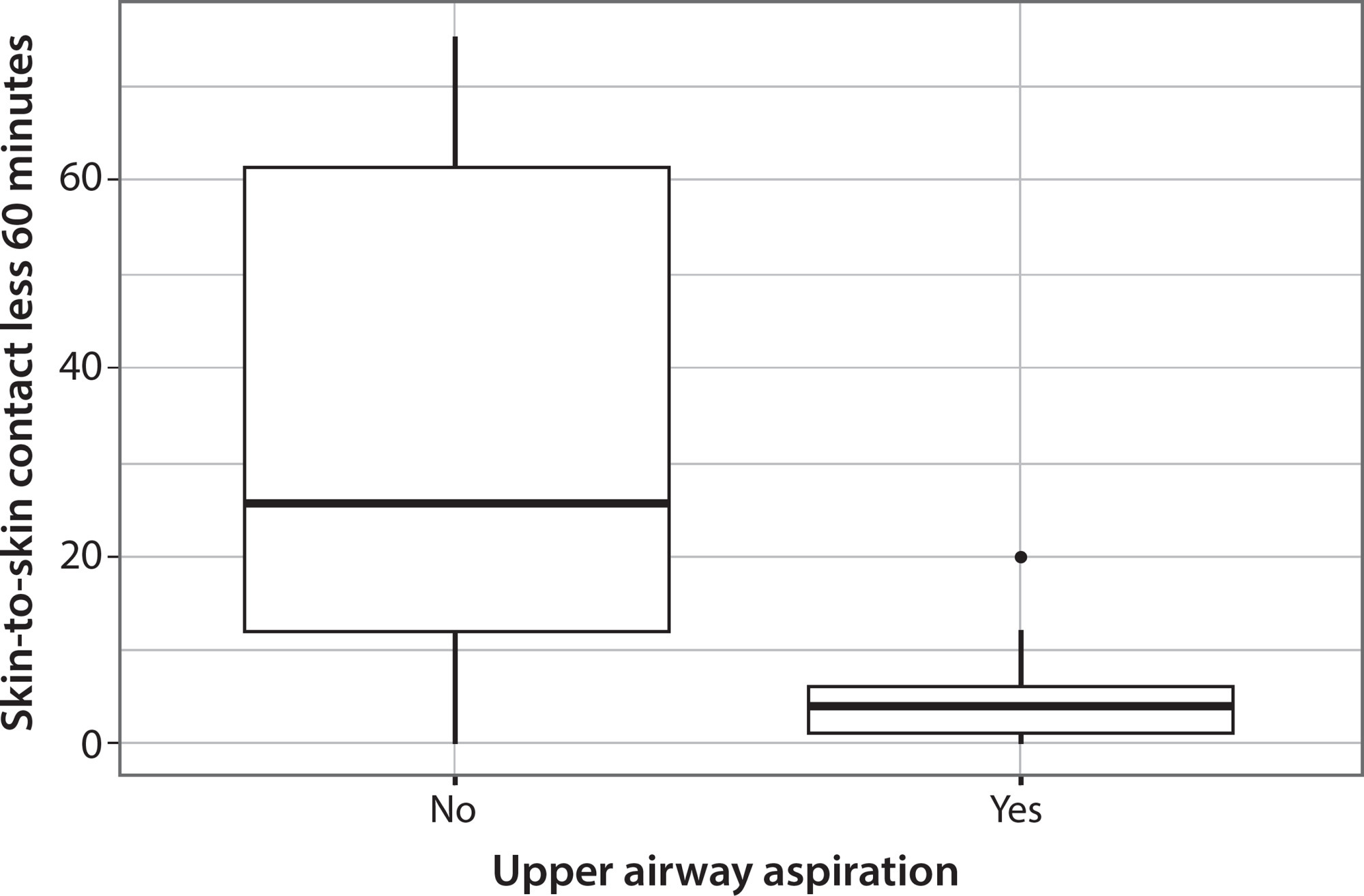
-
REVIEW05-28-2021
Scientific production about palliative care and communication in online journals: a scoping review
Revista Brasileira de Enfermagem. 2021;74(2):e20190378
Abstract
REVIEWScientific production about palliative care and communication in online journals: a scoping review
Revista Brasileira de Enfermagem. 2021;74(2):e20190378
DOI 10.1590/0034-7167-2019-0378
Views0See moreABSTRACT
Objectives:
to characterize publications about palliative care and communication, with an emphasis on the approaches addressed, disseminated in online journals.
Methods:
it is a scope review, in which the mnemonic strategy Problem, Concept and Context was used, based on database research. The sample consisted of 86 publications.
Results:
most publications were written in the English language, published in the journal BMC Palliative Care, and with level of evidence IV. As for the approaches approached, the following stand out: Importance of communication in palliative care; Breaking the bad news in palliative care; Training professionals/staff to communicate in palliative care; and Communication strategies in palliative care.
Final Considerations:
the review made it possible to map a significant number of publications on palliative care and communication. It is recommended to produce new studies with better scientific evidence that guide the assistance of health professionals.
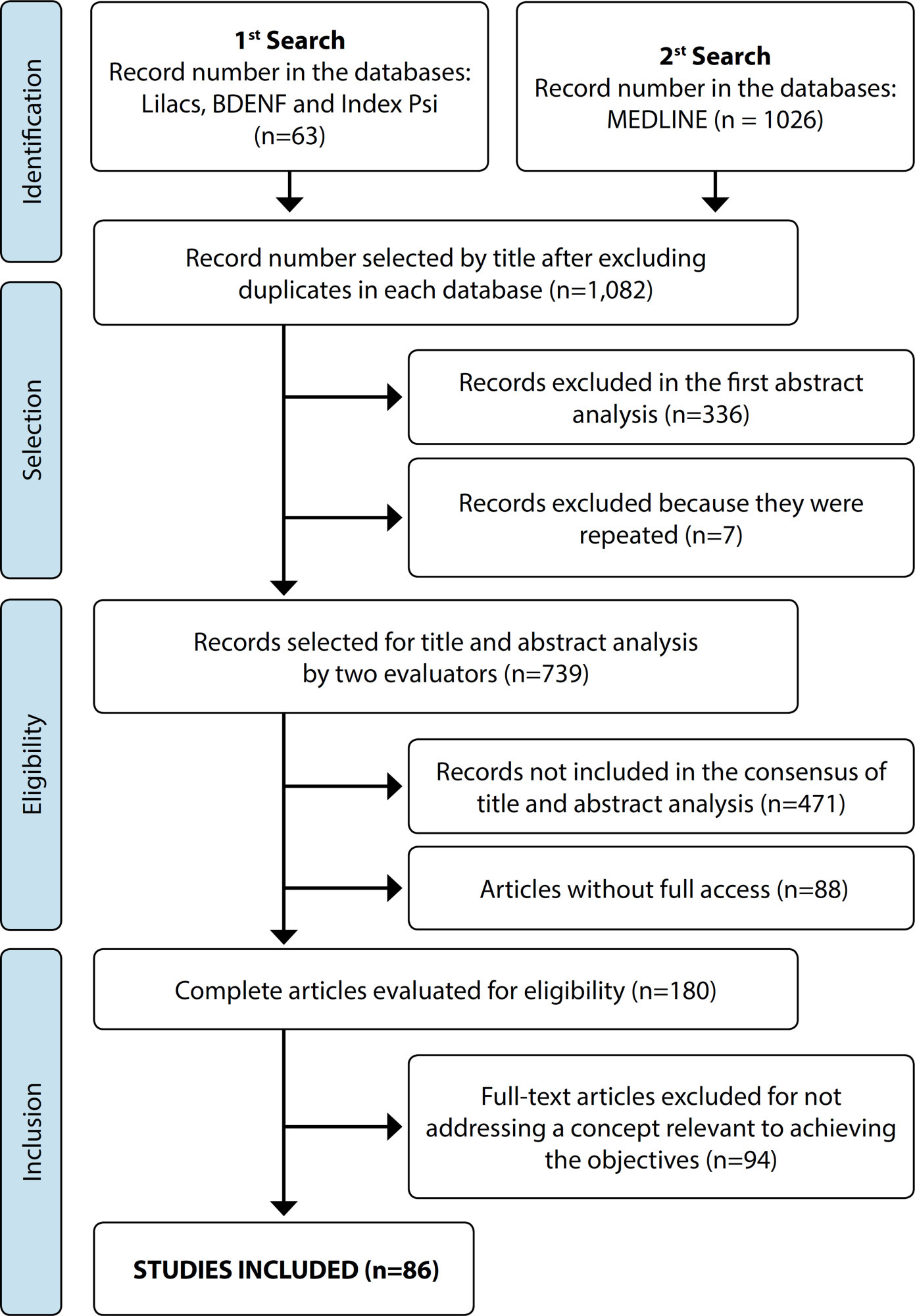
-
REVIEW05-21-2021
Vertical transmission and COVID-19: a scoping review
Revista Brasileira de Enfermagem. 2021;74:e20200849
Abstract
REVIEWVertical transmission and COVID-19: a scoping review
Revista Brasileira de Enfermagem. 2021;74:e20200849
DOI 10.1590/0034-7167-2020-0849
Views1See moreABSTRACT
Objective:
Analyze available evidence related to SARS-CoV-2 infection and vertical transmission.
Methods:
Scoping review, according to the Joanna Briggs Institute and PRISMA-ScR. Searches were conducted in five electronic databases to find publications about coronavirus infection and vertical transmission. Data were extracted, analyzed and synthesized by three independent researchers using a descriptive approach.
Results:
The search resulted in 76 publications. After selective steps, 15 articles – retrospective descriptive or case studies – were analyzed, all in English. In order to track the infection, specimens were collected from neonates through nasal swabs and C-reactive protein from breast milk, cord blood, amniotic fluid, placenta and vaginal secretion was analyzed. A small percentage of neonates tested positive for COVID-19, but these cases were not attributed to vertical transmission.
Conclusion:
Vertical transmission could not be demonstrated. Research protocol registered with the Open Science Framework (https://osf.io/fawmv).
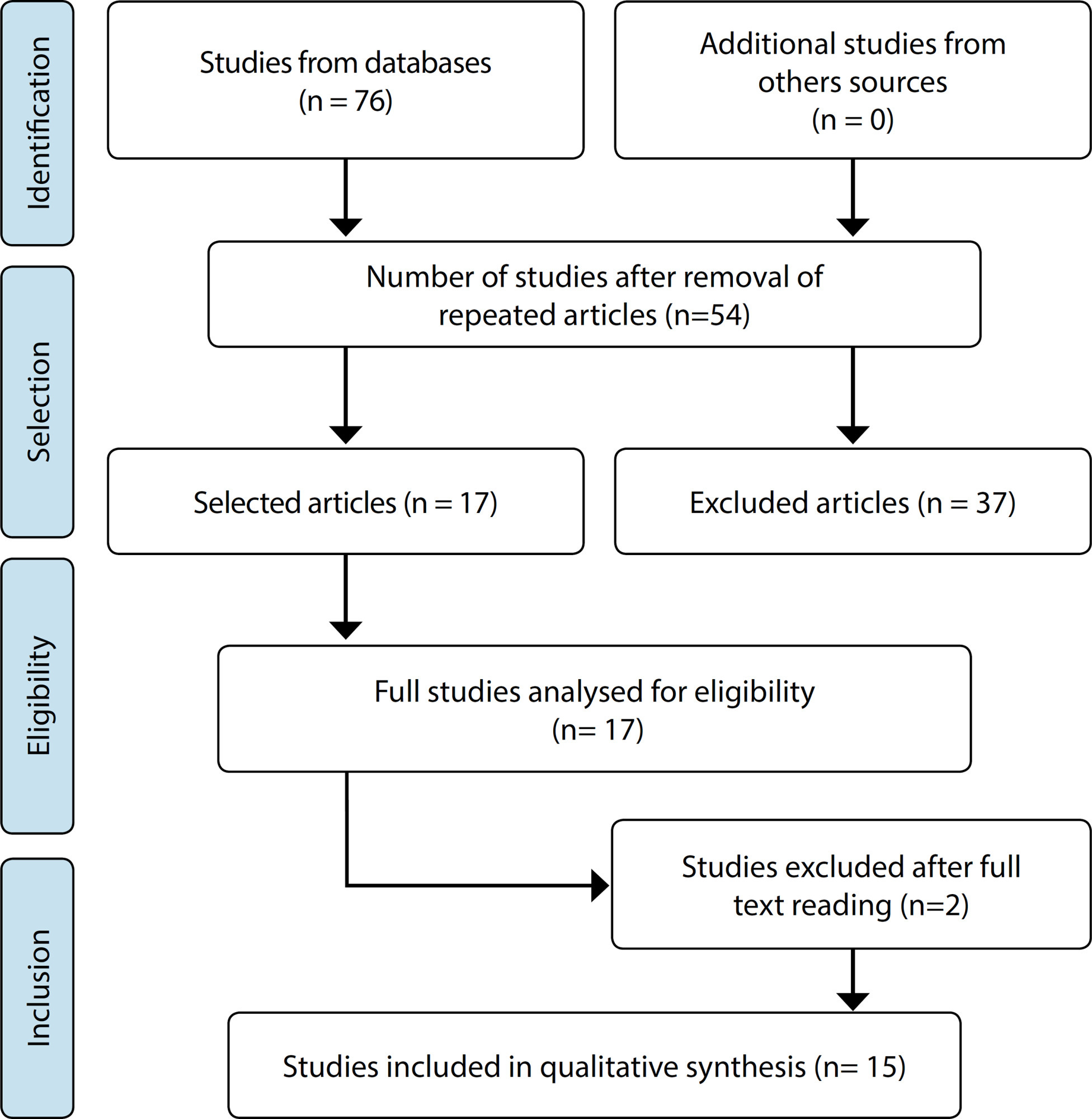
-
EXPERIENCE REPORT11-13-2020
Pedagogical mediations for non-formal nursing teaching during the COVID-19 pandemic
Revista Brasileira de Enfermagem. 2020;73:e20200499
Abstract
EXPERIENCE REPORTPedagogical mediations for non-formal nursing teaching during the COVID-19 pandemic
Revista Brasileira de Enfermagem. 2020;73:e20200499
DOI 10.1590/0034-7167-2020-0499
Views0See moreABSTRACT
Objective:
to report the experience of developing pedagogical mediations in a Virtual Learning Environment implemented in a nursing faculty during the COVID-19 pandemic.
Methods:
an experience report on the construction of a distance course aimed at graduates and residents of a nursing faculty at a public university located in the city of Rio de Janeiro.
Results:
the course’s conception, operationalization and implementation were the result of a collective work that culminated in a non-formal, virtual and problematic teaching process, which reached a participation rate of 82% of enrolled students.
Final considerations:
even in times of social isolation, the course promoted collaborative learning of knowledge about COVID-19 and strengthened the relationship between professors and students. The possibility of carrying out distance activities based on solid methodological proposals that contradict the content logic often observed in distance learning is emphasized.
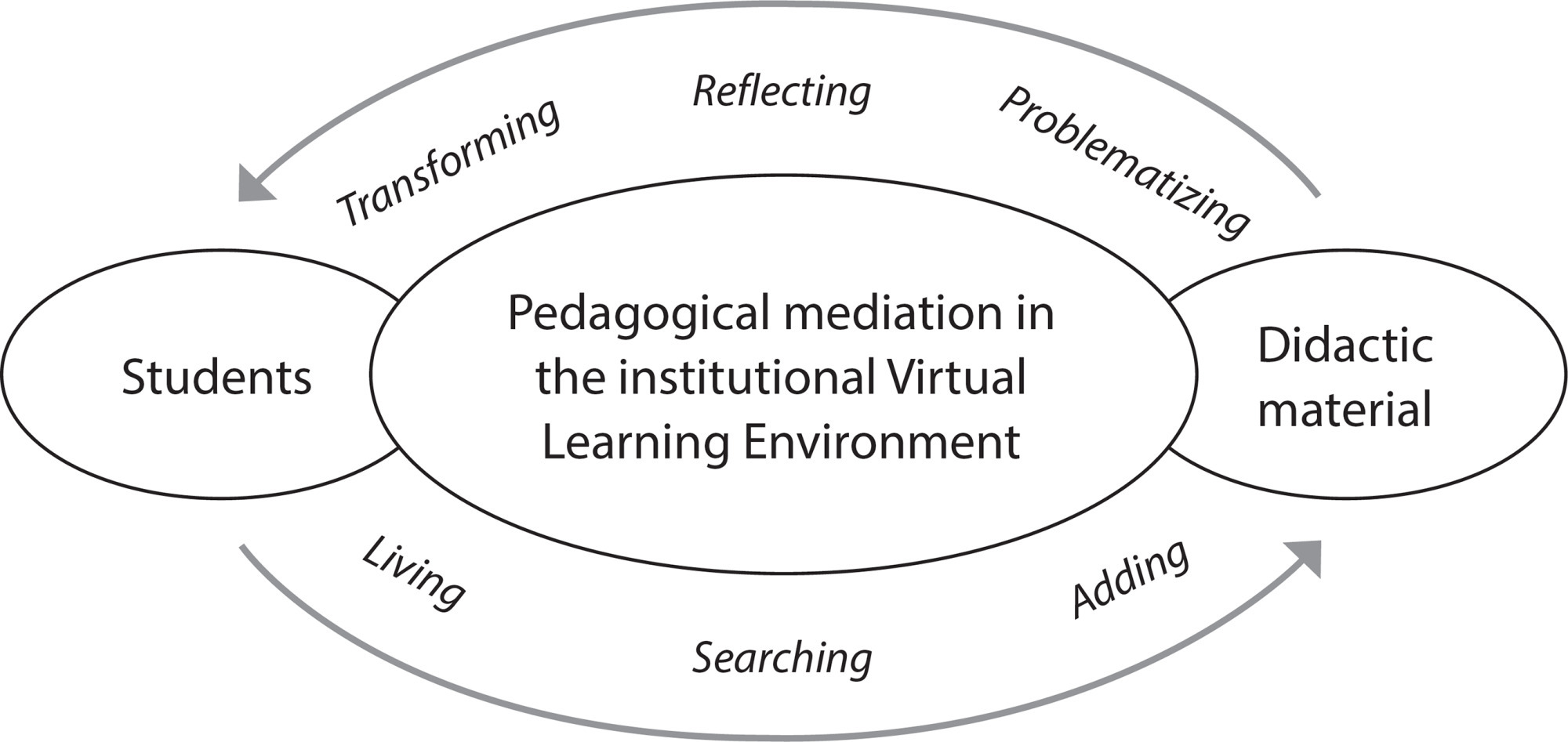
-
ORIGINAL ARTICLE04-07-2023
The use of toys by nursing as a therapeutic resource in the care of hospitalized children
Revista Brasileira de Enfermagem. 2023;76(2):e20220433
Abstract
ORIGINAL ARTICLEThe use of toys by nursing as a therapeutic resource in the care of hospitalized children
Revista Brasileira de Enfermagem. 2023;76(2):e20220433
DOI 10.1590/0034-7167-2022-0433
Views0See moreABSTRACT
Objectives:
to describe the use of toys by nursing during the care of children in the inpatient unit; to analyze the factors that influence the use of therapeutic toys by nursing in the care of hospitalized children.
Methods:
qualitative research, conducted in a pediatric hospital in Rio de Janeiro between July and August 2019. Semi-structured interview and thematic analysis were used as methodological procedure.
Results:
the 12 nurses and 7 nursing technicians revealed minimizing fear, relieving tension, and creating a bond between the child and the professional as the main benefits; they use as resources: children’s toys, hospital materials, cartoons, and children’s videos. The high demand for work, deficit of human resources, and appropriate ludic materials are factors that interfere with the use of toys as a therapeutic resource.
Final Considerations:
although the participants recognize the importance of the toy as a therapeutic resource, there is no systematization of its use in pediatric practice.
-
ORIGINAL ARTICLE03-30-2020
Implication of the training ad continuing education process for the interprofessional performance
Revista Brasileira de Enfermagem. 2020;73(2):e20180359
Abstract
ORIGINAL ARTICLEImplication of the training ad continuing education process for the interprofessional performance
Revista Brasileira de Enfermagem. 2020;73(2):e20180359
DOI 10.1590/0034-7167-2018-0359
Views0See moreABSTRACT
Objetives:
to analyze the implication of the training/continuing education process of professionals of the Expanded Nucleus of Family Health and Basic Care (Portuguese acronym: Nasf-AB) for their interprofessional performance.
Methods:
a qualitative case study performed with Nasf-AB teams representative of four macro-regions of health of the state of Santa Catarina. Participation of 43 professionals, who answered collective interviews. The results were later submitted to thematic analysis.
Results:
the training is strongly influenced by the Biomedical Model, which acts as an obstacle to interprofessional performance, given the challenges in the daily routine of Nasf-AB professionals. Continuing education emerges as a potential for the successful collaborative work among teams, and between the teams and Family Health professionals.
Final considerations:
there are important limits in the training of professionals. However, the constant interprofessional development promoted by strategies of continuing education contributes to broaden the support and collaborative practices that qualify services and strengthen Basic Care.
-
REFLECTION07-10-2020
In defense of the Unified Health System in the context of SARS-CoV-2 pandemic
Revista Brasileira de Enfermagem. 2020;73:e20200247
Abstract
REFLECTIONIn defense of the Unified Health System in the context of SARS-CoV-2 pandemic
Revista Brasileira de Enfermagem. 2020;73:e20200247
DOI 10.1590/0034-7167-2020-0247
Views0See moreABSTRACT
Objective:
To discuss the political and structural conditions for establishing the Unified Health System (UHS – Sistema Único de Saúde, SUS) in coping with the SARS-CoV-2 pandemic.
Methods:
Theoretical-reflection study.
Results:
At the first moment named “The global and the local in facing the SARS-CoV-2 pandemic” is presented the health crisis that took place worldwide and the government actions to combat COVID-19. A second moment named “Between dismantling actions and resistance, the UHS is the best way to face the SARS-CoV-2 pandemic”, reflects on the neoliberal attacks on the health system and how it resists, remaining the main pandemic response strategy.
Conclusion:
The strengthening of democracy and the defense of the UHS are the way out of the crisis. It is believed that this reflection generates – in everyone who deals with caretaking – the political action, the ethical attitude, the desire for valorization and the spirit of struggle in defense of the UHS and human life.
-
ORIGINAL ARTICLE08-19-2019
Psychosocial risks related to the nurse in the psychiatric hospital and management strategies
Revista Brasileira de Enfermagem. 2019;72(4):834-840
Abstract
ORIGINAL ARTICLEPsychosocial risks related to the nurse in the psychiatric hospital and management strategies
Revista Brasileira de Enfermagem. 2019;72(4):834-840
DOI 10.1590/0034-7167-2017-0311
Views0See moreABSTRACT
Objective:
To characterize the presence of psychosocial risks related to the work of the nurse in a psychiatric hospital and the strategies for managing these risks.
Methods:
Qualitative, in which 25 nurses from a psychiatric hospital participated using semi-structured interviews from November 2014 to January 2015. Data analysis was performed using the thematic method.
Results:
The results showed psychosocial risks related to the work of psychiatric nurses, such as: insufficient academic training; lack of preparation and maintenance of equipment; poor relationship with colleagues; shortage of human resources and lack of capacity building; conflict between the demands of the home and work, as well as strategies for managing psychosocial risks such as family, cinema, music, reading, among others.
Final considerations:
This study should provoke the reflection of managers and future nurses regarding the working conditions in a psychiatric hospital and possible psychosocial risks to which they are exposed.
Search
Search in:
Nuvem de Tags
Adolescente (85) Atenção Primária à Saúde (239) COVID-19 (91) Criança (91) Cuidados de Enfermagem (269) Educação em Enfermagem (151) Educação em Saúde (139) Enfermagem (930) Enfermagem Pediátrica (86) Estudantes de Enfermagem (77) Estudos de Validação (131) Família (87) Idoso (208) Promoção da Saúde (99) Qualidade de Vida (104) Saúde do Trabalhador (86) Saúde Mental (145) Saúde Pública (82) Segurança do Paciente (150) Tecnologia Educacional (100)



